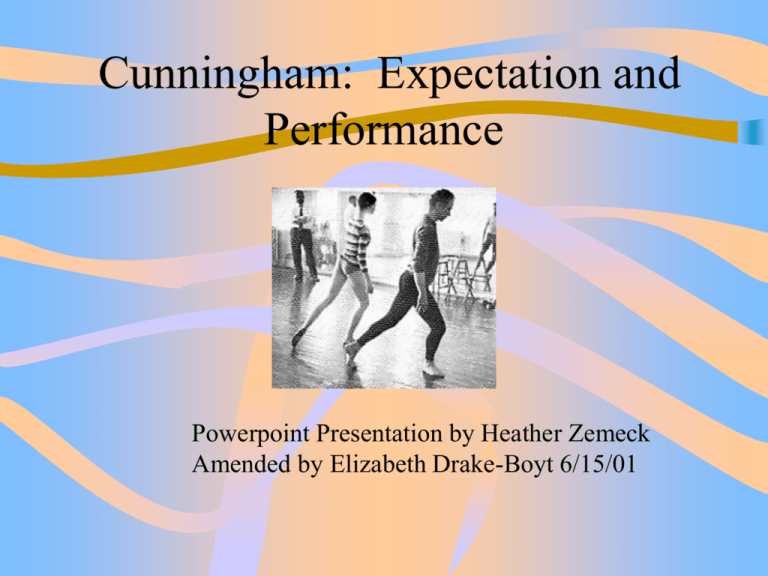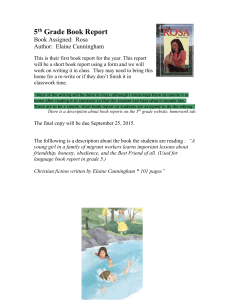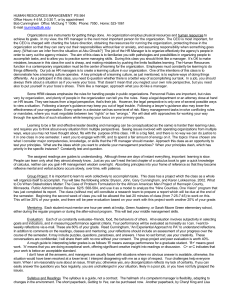Expectation and Performance
advertisement

Cunningham: Expectation and Performance Powerpoint Presentation by Heather Zemeck Amended by Elizabeth Drake-Boyt 6/15/01 How does Roger Copeland, in his article “Merce Cunningham and the Politics of Perception” discuss painting and drama? What do post-modernist concepts of painting and the dramatic forms developed by Bertolt Brecht have to do with the dance art of Merce Cunningham? Breaking through the mold of automatic artistic response . . .even the subconscious is in danger of becoming fully “acculturated” amidst the sensory overload environments of 20th century consumer society. (Copeland: 311). How does Cunningham separate “. . .the product from the process of its creation?” Both abstract expressionism and modern dance proceeded from Freud’s belief that below the “cultural” lies the “natural” id. . .In order to re-establish contact with the natural. . .self, one must suspend rationality. What techniques does Cunningham use to suspend rationality in his dances? What approach to drama did Brecht develop in his plays in order to distance the audience from a pre-arranged relationship to the narrative? List some ways in which Cunningham separates, distorts, or otherwise alters dance elements which have traditionally been linked. Why would these artists want to prevent passive absorption of their works? Pollock wanted to express himself (his innermost self) in the most spontaneous, unmediated manner possible. . .Ultimately, Pollock discovered the wisdom of Martha Graham’s oft-quoted aphorism, “Movement does not lie.” (Copeland: 308-9). If mediation between painter and painting is removed, how does that affect mediation between painter and viewer? Does Cunningham also remove or alter mediation between his dances and their audiences? How does a severance of meaning between dance and music reflect a separation of meaning between artist and audience? Does the audience create meaning? Why or why not? Cunningham’s Dance by Chance Approach The choreography, the score, the settings are all created in isolation and often don’t encounter one another until the very first performance (Copeland: 312).Cunningham might toss a coin to determine the number of dances, the sequence of movement, the spatial pattern, etc. (WD 310) Discuss how does the resulting dance affects the audience. If Cunningham “felt that this invoked a wholly “impersonal”, more objective sense of order” . . . How would this approach to dance make Cunningham’s work “perceptual training”? How is this different from art as entertainment? Do you feel that Cunningham’s work is successful at detaching itself from the natural world? Why or why not? Small Group Discussion: Examine Post-modernist Expressionism in these terms: Continuity of time and space Audience expectations vs. the artist’s goals The relationship of the process of creation and its product How is meaning negotiated between the artist, the work, and the viewer of that work? Who invests the work of art with its meaning? Does the mass production of images have any influence on the structure, purposes, or vision of Post-modernist Expressions? Works Cited Roger Copeland, “Merce Cunningham and the Politics of Perception” from What is Dance? Roger Copeland and Marshall Cohen, Eds. Oxford University Press, NY: 1983. (p. 307-324). Michael Katz, photograph (insert) of Rauschenberg’s Monogram, from the Bride and the Bachelors: Five Masters of the AvanteGarde. Calvin Tompkins, Viking. New York: 1969. Calvin Tomkins, photograph (insert) of Cunningham in studio rehearsal, from the Bride and the Bachelors: Five Masters of the Avante-Garde. Calvin Tompkins, Viking. New York: 1969. Works Cited Jack Mitchell, photographs of Merce Cunningham, from American Dance Portfolio: Photographs by Jack Mitchell. Dodd, Mead & Co. NY: 1964. (p. 30). Jackson Pollock: No. 14, 1948. Reproduced in The Story of Art, E. H. Gombrich, Ed. (13th Ed). Phaidon Press, Ltd. Oxford: 1978. (p. 479). Hans Namuth, NY, photographer. “Jackson Pollock at work in his studio, 1950”, from Arts and Ideas, William Fleming (7th Ed.)Holt, Rinehart and Winston, NY: 1986. (p. 459). Jackson Pollock: Lucifer (1947) from Arts and Ideas, William Fleming (7th Ed.)Holt, Rinehart and Winston, NY: 1986. (p. 459).





